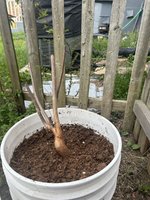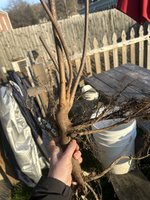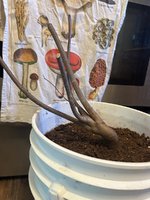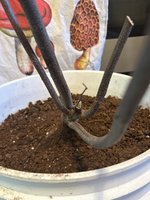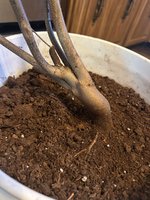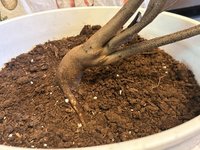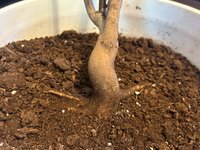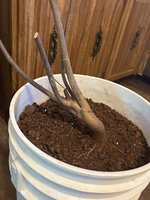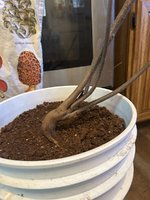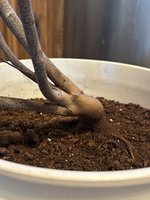It is quite difficult to give good advice with only a couple of 2D shots of a trunk to go on. Subtleties like how each trunk bends in relation to the others can be the difference between a mediocre tree and a good one.
Some basic guidelines for multi trunk trees:
1. Good multi trunk trees divide close to soil level.
2. Trunks that harmonize - similar bends are desirable.
3. Different trunk thickness and height is attractive and believable.
4. Even numbers of trunks (except 2) are much harder to arrange attractively than uneven numbers.
5. Good taper in trunks and branches is desirable as usual.
First up. Trees need to grow to produce food and energy to replace the lost roots after collection. We generally don't rush straight into styling immediately after transplant. Let the tree grow and recover this summer. Any styling and pruning can be next season.
The pictures show the trunks fork well above the main roots so not ideal for multi trunk style. There are choices - remove some of the trunks for an informal upright style tree. OR grow new roots closer to where the trunks fork.
I'm having a little trouble visualising the trunk lines and direction of all 4 trunks but the thicker one stands out because it appears to be much stronger and straighter than the others. Given that and that 3 trunks is usually better than 4 consider chopping the larger trunk if you still go for multi trunk.
It's not real clear how the 3 smaller trunks grow in relation to the lower trunk and roots but I suspect the angle will be hard to work with if the current trunk and roots are retained.
No real difference in thickness of those 3 trunks. Is it possible to retain the thicker trunk and 2 of the smaller ones? Need to examine trunk lines and direction to so if there's any harmony with thick and 2 others.
Second option is to look for a single trunk tree. Follow the curves from root level up to the trunks to find which trunk continues that flow best. Remove any that don't flow well. My guess is the thickest one looks awkward and also too thick compared to the lower trunk. I suspect I'd take it off first and see what that left me.
It looks like the remaining trunks are all quite long and skinny. I'd suggest some or all of the trunks will need to be reduced by at least half at some stage. This pruning and the subsequent new shoots will give bends, taper and branching in the future trunk.
By all means keep considering how to approach this tree but please let it recover before doing any more. Keep an open mind and be prepared to change tack if one or more of the trunks doesn't survive after transplant.
Good luck with the tree. I'm optimistic it will survive. There's plenty of roots (I would almost certainly have cut them much harder) and plenty of trunk to grow leaves.


